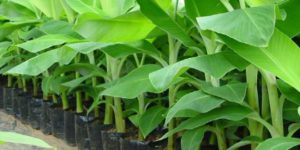Thanks to increasing demand and enticing market costs, banana farming is gaining momentum. till recently, use of standard suckers as planting material has been the sole choice in banana farming. This methodology is most popular by several farmers. As a result, it needs less inputs and therefore the suckers are often planted forthwith within the field. However, the most plight with this sort of planting system is that the bananas simply suffer from pests and diseases like wilt disease, Sigatoka and microorganism Xanthomonas wilt (BXW).
Banana weevils and nematodes also are common in crops planted from suckers. moreover, virus like banana streak and clustered high sickness also are unfold through suckers. Given these inadequacies, the standard banana farming ends up in high mortality rates within the field. If they establish, they take long to mature and therefore the yield is often low. To deal with this downside, tissue-culture bananas are introduced.
Tissue-culture technique, well-known as micro-propagation, permits multiplication of uniform and top-quality plant clones since they inherit the properties of the parent plant physically and genetically. Through this method, additional saplings are made inside a brief time while not the method of pollination. As a result, healthy, virus-free and uniform seedlings are made. however most of the people mistake tissue-culture for genetically changed product.
Development of tissue-culture bananas
[caption id="attachment_728" align="alignright" width="300"] Banana-Tissue-Culture farming in Kenya[/caption]
Banana-Tissue-Culture farming in Kenya[/caption]
Tissue-culture plantlets are made below sterile conditions in an exceedingly laboratory for a few weeks. The plantlets are then hardened in an exceedingly greenhouse for 6 weeks. Notably, tissue culture races the multiplication method considerably and up to two thousand. Healthy bananas are often made from one shoot through this methodology. standard bananas, on the opposite hand, manufacture ten suckers in six months.
Similarly, tissue-culture bananas manufacture fruits in 340 days as compared to 420 days for normal bananas. The common hectare yield for tissue-culture bananas is 30-40 tons, doubly the yield for ancient breeds. Uniform growth and virtually synchronized maturity can facilitate correct management of harvests, improve quality of the merchandise and facilitate estimate a stronger output price.
Production and Market of Tissue-Culture Banana
Production and selling of tissue-culture bananas are so additional economical. To reap full edges from the tissue-culture technique, a farmer should have giant quantities of unpolluted and superior planting material, promote smart farm hygiene practices through correct management of the crop. This can decrease the yield losses thanks to pests and diseases.
Further benefits accruing from the prevalence of the planting TC banana is its early mature and maturing amount, larger bunch weights and the next annual yield per unit of land. Standard planting materials carry pests and diseases from the mother plant. However, there are means that to scale back cuss load before planting.
Tissue-culture plantlets, on the opposite hand, are free from pests, plant and most microorganism pathogens. If they need been properly indexed, they ought to even be freed from viruses. However, they're simply infected with pests and diseases if transplanted in troubled soils.
Tissue-culture plantlets are dearer than standard planting materials and will not be promptly accessible, as several counties don't have the facilities to supply them. Moreover, the number of cultivars sold-out by the laboratories is mostly restricted. Tissue-culture plantlets conjointly need acceptable management practices right when being transplanted to the sphere.
Growing Tissue-Culture Bananas
The farm must have the correct conditions for the expansion of bananas, that act from associate altitude of one, 800 meters higher than water level and a minimum rain of 1000mm per annum, that is especially essential throughout flowering. Farmers in low rain areas ought to make sure that irrigation is completed throughout. Soils ought to be fertile and well drained to avoid water work.
Farmers will get these plantlets from licensed nurseries half a month before planting, pits of 3 feet by 3 feet by 3 feet ought to be ready. Dirt ought to be separated and well rotten manure mixed with the soil, fertilizer and therefore the suggested nematicide. The banana hole ought to be stuffed with the mixture, and therefore the plantlets planted 30cm deep within the hole.
The soil ought to then be firmed. Dry mulches ought to be put to retain wet whereas significant banana stems ought to be supported to avoid injury. Recent pathological leaves ought to be removed because of de-leafing ensuring healthy growth. Harvesting begins when 15-18 months, and a light-weight shiny look means the banana is prepared for harvest.
Harvesting ought to be delicate to avoid bruising of the bananas. The fruit ought to be quickly hold on in an exceedingly cool, dry place wrapped in banana leaves or grass to avoid bruising. If for export, they ought to be washed employing a disinfectant and branded. it's apparent that tissue-culture bananas have several benefits over standard suckers. However, there are hurdles that limit widespread uptake and best use of tissue-culture technology among granger farmers.
Related Content: Make money through passion fruit farming
Distribution of Tissue-Culture bananas
Distribution systems of tissue-culture plantlets to farmers is one key obstacle. Plantlets are typically distributed in giant quantities at supported costs by varied development partners, however this is often not property within the long-term. Tissue-culture plantlets are fragile, and their thriving depends on smart management by nursery operators and farmers, particularly within the early stages. To add it up, Kenya’s comparatively stable economy and every year spherical season holds nice potential for the native and export markets.
Tissue-culture bananas will facilitate increase production of this in style fruit. solely four per cent of banana exports originate from continent whereas the rest of the plantlets is big within the continent. This inequality may be a wonderful chance for farmers to produce their fruits to greater markets.
Also Read: GOOD RETURNS THROUGH HASS AVOCADO FARMING
Contact our offices for more information.











